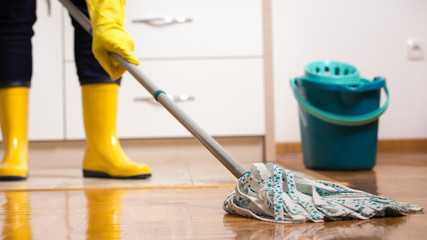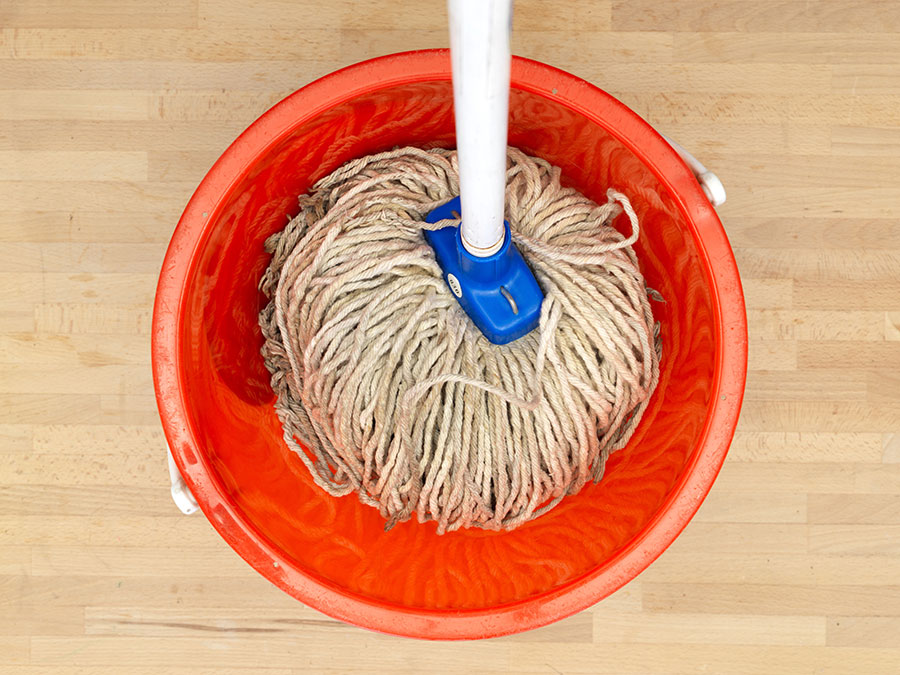
How to Clean a Smelly Mop in Just Under 2 Minutes
Cleaners Talk is reader-supported. This post contains affiliate links, we may earn a commission at no additional costs to you. As an Amazon Associate we earn from qualifying purchases.
It’s happened to all of us. Slowly but surely, a vaguely musty smell begins to creep into your nostrils. Worst of all, it’s coming from the direction of the place where you stash your cleaning supplies. Pretty soon it’s gone beyond an odd tickle in your nose and is a full-frontal assault of stink.
It’s your mop. The mop smells bad. Here’s how to clean a smelly mop and remove the odor:
To clean a smelly mop, mix together one cup of white vinegar (or three percent hydrogen peroxide) and one gallon of hot water. Let the mop head soak for at least 12 hours before wringing it out and letting it dry in the sun. Always store the mop upside down in a dry place.
It may seem counterintuitive that the cleaning implements most often soaked in cleaning agents be the source of a foul odor, but it’s a lot more common than you think. Fortunately, there are steps you can take to clean a smelly mop in order to rectify the pungent situation and avoid encountering it in the future.
Why Do Mops Smell Bad?

We put our mops through the wringer - both literally and metaphorically.
They’re our soldiers in the war against grime and gunk on the floor and take a beating regularly. Though part of that process typically involves soaking in chemicals intended to break down dirt and bacteria, mop heads often become smellier than the floors they clean.
In most cases, this happens because of moisture retention. A damp mop head is the perfect place for bacteria to flourish, leading to that tell-tale smell. In some cases, mold and mildew may grow as well.
This isn’t fun for your nose, and it’s not good for your floors. Without a fix, your mop will most likely do a better job of spreading filth across your floors than it will clean them.
The problem extends beyond the mop and your floors, though.
In addition to creating an unpleasant aroma, unaddressed mold and mildew in a mop can spread to other areas of your home, making it more than a mild inconvenience.
Stop Stinky Mop Smells Before They Start

The best remedy for a smelly mop is to prevent the smell altogether. The best way to do so is to practice good mop hygiene. After every use of your mop, you should clean the mop itself. It is not enough to wring out the water left over from your cleaning tasks. The mop should be rinsed out with clean water, at a minimum.
It is advisable to clean the mop head using a combination of clean water and bleach or vinegar to ensure as many odor-causing bacteria have been eliminated before you hang it up for the day.
Once the mop head has been cleaned, it is crucial that as much water is eliminated from the fabric portion of the mop as possible. Wringing the mop – be it one with a cloth, yarn, or sponge head – is the first step, and it should be repeated until you’re not getting any more streams or drips from the application of pressure.
You must then store your mop in a way that facilitates efficient evaporation of the remaining moisture. If you live in a warm, dry climate, placing it outside and in direct sunlight can help speed this process.
These steps can help keep your mop head clean and keep the stink away. Now and then, though, a deeper clean of the mop head might be warranted.
How Can I Clean My Mop Head?
Now and then, giving some special attention to your mop head can ward off bad smells, extend its utility, and improve its cleaning power. But how to clean a smelly mop? The right way to pay that attention depends on the kind of mop head you have.
For instance, cloth mop heads are often washing machine friendly. Putting it in the laundry can be a quick and easy way to maintain its usefulness and zap any odors that might have developed, especially if you can use a bleach-based detergent.
It’s important to check that the mop head can be safely put in the washing machine, though.
Some are not built to survive the beating a wash cycle generates. Some yarn mop heads, for instance, are susceptible to fraying under those conditions, potentially leaving behind threads that can clog the machine, get on other clothes, or eventually transfer to your floors when you use it again.
This is where hand-washing your mop heads can be useful...
A combination of soaking the mop head and using your fingers to rub contaminants out of the fibers can get rid of the bacteria and dirt that combine to create that gross smell.
What Chemicals Should I Use When Cleaning My Mop Head?

In theory, the same chemicals used to clean your floors can be used to clean your smelly mop head. This is especially true if you use floor cleaning agents with anti-bacterial properties.
If your mop smells bad, though, harsher chemicals can make a world of difference. Bleach, specifically, is effective and thorough in eliminating stink-generating bacteria. Vinegar can also be an effective and less harsh option, which is especially useful if you’re working with an older mop head.
Generally, a ratio of one part chemical to three parts water will provide sufficient power in these situations.
Unfortunately, the smell of bleach or vinegar can be unpleasant, too. These smells will fade with time, but if you want to cut against that chemical scent, adding a couple of drops of lemon juice or lavender essential oils to your cleaning mix can provide some relief.
What If These Cleaning Tactics Don’t Get Rid of the Smell?
Mop heads are not designed to last forever.
Even with proper maintenance, you’re going to have to replace it eventually, if only to make sure it has enough structural integrity to get the job done.
Generally speaking, it is recommended that you replace your mop head every two to three months, though this timing depends on the frequency of use and the kinds of messes being tackled.
In some cases, even if the mop head is structurally sound, the impact of mildew in the mop head will be so severe that there is no amount of cleaning in the world that can salvage it.
In these cases, a replacement will need to be secured. Even if you probably could clean it thoroughly enough to get rid of the stench, it’s worth it to consider the trade-off. Will the amount of time spent cleaning the mop head be worth it relative to the cost of getting a new mop head altogether?
Related articles:
